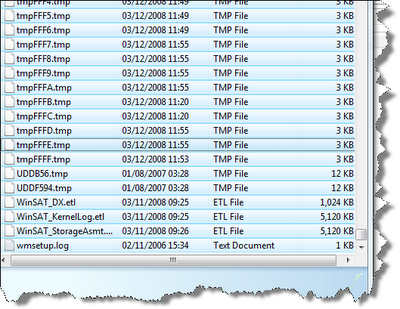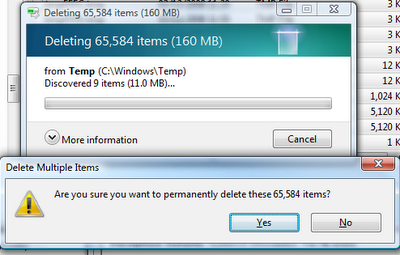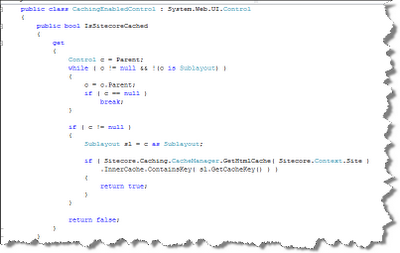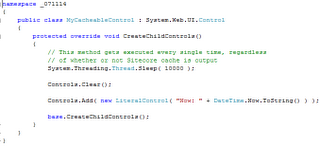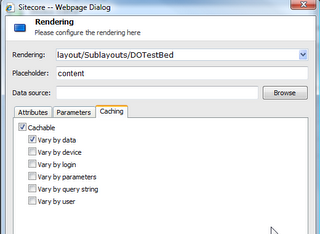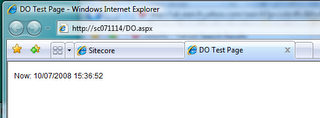Friday, December 19, 2008
TreelistEx not registering links in LinkDatabase
Thursday, December 18, 2008
Showing Sitecore how to improve...
A while back, Alex De Groot invited to an open debate on areas where Sitecore could improve. This post is my response.
Readers of this blog will have noticed, I often take a somewhat critical stance to Sitecore. What may not be so obvious at a first glance however is, my beef is not so much with the product itself, but rather Sitecore as the company behind the product. The issues that come from working with the product ultimately comes down to the practices that are in place in the company that creates it. Sure, a particular bug might be annoying but it's just the smoke - not the fire itself.
So I won't be requesting features, in short. In fact, if anything, I will request "no new features" at all; but instead point out that good solid project management practices, quality assurance, usability studies and whatnot make up a very important (if not the most important) part of any ongoing software development endeveaour. Even if I couldn't spell that right... ;-) But then - it is also obviously very easy for me to just sit here and say "hey guys, manage your stuff - how hard can it be?!". I've been doing software development for many years now, and if anything I've come to realise that perfection is more a direction than a goal in itself.
I've seen improvements in the way Sitecore has been working, especially over the last year or so. Documentation for instance, has always been a weakness when working with Sitecore. So I was very pleased to find, that documentation is taking on a whole new level with The Sitecore 6 Documentation Package - while far from covering everything there is to say about working with Sitecore, it's certainly a step in the right direction. Through Sitecore Support I've had the priviledge of looking at some of the other documents still being drafted, and I'm glad to see that this new trend is taking on. Documentation would have been top of my list still, as the first thing to improve. It doesn't matter that you have a good product, if noone knows about it. With that said however, for crying out loud guys will you fix and consolidate your online information already? Per Bering from Codehouse pointed this out as well as a comment to Alex' post. Your site search is absolute bollox and there is not a single other thing to say about it :P "Did you mean.. xsl rendering xsls rendering xslext rendering exslt rendering xslt rederings xslt renderingid xslt renderingitem xslt renderendtag " ... :P
Right now, the only way I am staying "on top" (if that's what I am, I don't know) of current Sitecore technical information is, by subscribing to roughly 20 Sitecore related blogs, chatting with people who work for Sitecore, chatting with other consultants who work for Sitecore partners and then as the last resort - the ultimate Sitecore tool; Reflector. I've even seen Sitecore support personnel themselves point developers in the direction of Reflector as a source for information. And while it's a great tool, I can't really believe this is how it is meant to be. Notice btw, how I deliberately didn't include SDN5 as a common source of information for me. While I go there, it's very rare that I am able to successfully find what I'm looking for there - so the fallback option is Sitecore Support. Fortunately I find Sitecore Support very good, at least :-) Enough about documentation however.
The second thing I would ask for, is for Sitecore to start eating their own dogfood. If it's not good enough for you to run your own site on, it's certainly not good enough for the very large developer base out here who has very limited access to documentation on the product. Update notes and changelogs don't really tell a useful story as I think most who work with the product will know. I've never seen a changelog saying that the "admin" user no longer comes with Danish locale as default in a blank Sitecore 6 - and that this breaks the way some fields work in Sitecore - nor have I seen a note that it was fixed. It might exist somewhere; see "searching" above ;-) Or what about Page Editor acting up and throwing exceptions if you happen to run Sitecore in a non "en" language context? Or breaks if you don't set a layout for the Print device? I would much rather wait an additional 3 months for any Sitecore release, if it means it has been fully implemented throughout the Sitecore organisation before being released to the general public. This will not cover all usage scenarios of Sitecore as a product - but it WILL get rid of "all those little annoyances" that are so very hard to explain to our customers. "Why does my image links break, if I do it this way instead of that way?" and so on. Fortunately, level 1 support is behind me - but then.. should we accept these kinds of issues at all?
Finally, and just for good measure, I will throw in a product feature comment. The Page Editor. Brilliant, but hugely underestimated right now. Find a good way to solve the problems of configurable controls (a.la SharePoint WebParts) getting easily added to layouts - and come up with some form of layout or rendering inheritance as pointed out by another commentator. Not necessarily saying the suggested approach is the best one (although it very well might be), but it certainly is something that I would like to see addressed and solved. In summary:
- Document. Love your developer base, please ;-) Take a look at what the competition is doing, maybe expecting a new MSDN is asking too much after all ;-)
- Eat it yourselves. First.
- Keep evolving the Page Editor, which I honestly believe can be one of the absolute killer features and opens up a lot of opportunities for new development areas.
That's not asking for much is it? ;-) We were invited however.
Wednesday, December 03, 2008
Sitecore Packager throwing System.IO.IOException: The file exists.
[IOException: The file exists.] System.IO.__Error.WinIOError(Int32 errorCode, String maybeFullPath) +2056933 System.IO.__Error.WinIOError() +30 System.IO.Path.GetTempFileName() +2715024 Sitecore.Shell.Applications.Install.Commands.BuildPackageCommand.Execute(CommandContext context) +106
And so on. So looking at this, turns out the packager isn't really to blame here. Except maybe for the fact that it should have cought this exception and given a better error message :P
Looking into my C:\WINDOWS\TEMP folder revealed:
And further looking at MSDN reveals:
The GetTempFileName method will raise an IOException if it is used to create more than 65535 files without deleting previous temporary files.
The GetTempFileName method will raise an IOException if no unique temporary file name is available. To resolve this error, delete all unneeded temporary files.
A bit of housekeeping, and voila
All good again :-)
Thursday, September 25, 2008
CorePoint.DomainObjects Update 1
Monday, September 22, 2008
Update-3 (080912) Released
Tuesday, July 15, 2008
Return to the not-so cacheable Control in Sitecore 5.3
public class MyCacheableControl : CachingEnabledControl
{
protected override void CreateChildControls()
{
if ( IsSitecoreCached )
return;
// Normal functionality here
Monday, July 14, 2008
How do you DO?
As someone recently commented, this blog is not overall a very positive one. And while it was never my intention to write a fanboi blog, it doesn't have to be all negative either ;-)
Overall, I have grown to like the Sitecore product quite a lot. I find, that I am able to apply it to most any scenario my clients throw at me (though there was this one client of my former employer, who wanted the CMS to realtime translate her articles into all of the other installed languages... :P) - It helps me get the job done.
Now I am sure that most people who work implementing Sitecore solutions on a regular basis has adapted a way of their own. Either in the form of socalled "Helper" libraries, or maybe a drawer full of ready to go renderings for topmenus, left menus, breadcrumbs and whatnot. Me, as I often work with Sitecore jobs that involve tight integration with Sitecore data and external data (either in form of added Sitecore functionality, or migration from third party systems for instance), my most important tool in the drawer is the ability to work following modern OO practices - Domain Objects if you will.
I decided it is time for me to share something with the Sitecore community that makes it easy to do just that. Basically, this is my "5th generation" data layer if you will, although I would probably huff over anyone classifying this as generic "DAL".
Not only is it being shared, it is being shared in full. It is being released under the GNU General Public License v3, sources and all, in the hope there are other people out there that can see the benefit of the approach I suggest and will find it useful.
Here's a quick snippet of how Sitecore integration looks, when using it:
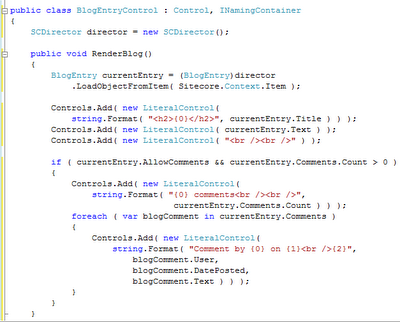
Enough rambling for now. Head on over to the official site in the Sitecore Shared Source Library to grab your copy, and to have a look around.
- Trac space for CorePoint.DomainObjects
- Getting started guide
- Release blog post from Jimmie Overby, Sitecore Shared Source Coordinator
- Entry point on SDN
Thursday, July 10, 2008
Say goodbye to Sitecore 5.3
In case you didn't follow. Sitecore will execute everything, thereby allowing your webserver to consume expensive resources (and even stop and wait for the result), then dump the result and use what it has in cache already.
Thursday, June 05, 2008
is not a valid Win32 application. (Exception from HRESULT: 0x800700C1)
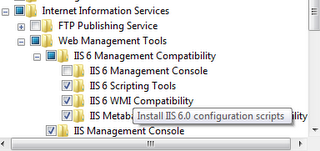
Executing the command line and a quick IISRESET just for good measure, and all the problems went away. Now I doubt running Sitecore 5.3 in this way is really supported, but it gets the job done. I will keep a lookout for side effects.
Sunday, March 02, 2008
Web Application Project revisited
- Configure your explorer (not IE, your Windows Explorer) to "Show Hidden Files and Folders" (I won't post screenshots, as my current Vista installation is in Danish)
- Go to your root "/Website" directory for your solution. Mark the two folders; "App_Config" and "Sitecore", rightclick, and check the box "Hidden" (found right below readonly). It will ask you if this should apply to subitems as well, just say no to that.
- Fire up your favorite Visual Studio (I just tried this with Visual Studio Express 2008 and it worked fine), go "Open Website" (or "Open Website in Existing Folder", all depends a bit on what VS version you are using)
And there we go.
From here, I rightclicked the "Website root" and selected "Add ASP.NET Folder" -> "App_Code", tossed a few class files in there, made up a few references to this code from both .aspx pages and .ascx sublayouts... it all ran fine, and I never needed to manually compile (ah, the good old CTRL-SHIFT-B) once.
Does this qualify as conclusive evidence this will work? Absolutely not. But if the method of moving the folders out is "under evaluation", maybe this should be as well? Seems to me to be very straightforward.
I'll work with it for a while, see if I bump into any unexpected mishaps.
